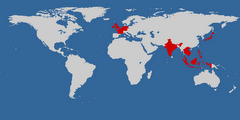
Sunday, December 31, 2006
christmas in langkawi
Saturday, December 23, 2006
penang
Wednesday, December 20, 2006
the cameron highlands
Monday, December 18, 2006
no longer flying solo
We've pretty much hit the ground running travel wise. Just spent a couple of days in Kuala Lumpur knocking off the sites, and have now moved north, by bus, to the Cameron Highlands to visit the big tea plantations. In a day or two we will travel further northward to Penang to engage with some colonial history. After Penang, we will either go on to Langkawi for the beaches, or east to the Pulau Perhentian Islands on the north east coast. The decision will depend on where the weather seems to be best. Finally, we will work our way back down to Taman Negara, where we will stay and go jungle trekking, ending up by returning to Kuala Lumpur, bringing us back where we started.
Yesterday, Raj and I went to the Batu Caves just outside Kuala Lumpur. The caves, containing a Hindu Shrine, are halfway up a limestone cliff and can only be reached by a climb of two hundred and seventy two steps. They have been used as a shine for over a century and are famous because of the annual Thaipusam Festival which they host, attended each year by a million repenting pilgrims. As penance for their sins they climb the cave steps with weighted hooks hanging from their backs, and spikes pierced through their cheeks. It's a sight to behold (I've seen a documentary by Alan Whicker on it) but when I was there it was all quiet and calm and very hot.
Friday, December 15, 2006
more from the muddy confluence
Wednesday, December 13, 2006
kuala lumpur
Full name: Federation of Malaysia
Population: 25.3 million (UN, 2005)
Capital: Kuala Lumpur
Area: 329,847 sq km (127,355 sq miles)
Major languages: Malay (official), English, Chinese dialects, Tamil, Telugu, Malayalam
Major religions: Islam, Buddhism, Taoism, Hinduism, Christianity, Sikhism
Life expectancy: 71 years (men), 75 years (women)
Monetary unit: 1 ringgit = 100 sen
Main exports: Electronic equipment, petroleum and liquefied natural gas, chemicals, palm oil, wood and wood products, rubber, textiles
GNI per capita: US $4,960 (World Bank, 2006)
Internet domain: .my
International dialling code: +60
Monday, December 11, 2006
wanted - brunei waiter or waitress
- Able to demonstrate a strong ability to confuse very simple orders. For example, will always bring customer coffee when tea has been requested. (Essential).
- Developed skills in sitting at the back of the restaurant, slouching, and looking bored. (Essential).
- Good communication skills. Able to chit chat with other colleagues about local gossip, what's on tv, and a range of subjects not relating to the restaurant or serving customers. (Essential).
- Should be able to use initiative. For example, if the customer asks for local directions the candidate should be able to use his or her discretion, and say 'eerr... don't know.' (Essential).
- Willing to spend long periods eating the restaurant food for free. (Desirable).
Knowledge:
- Competent in using text messaging applications including Nokia and Samsung. Should be able to demonstrate ablility to text friends whilst ignoring customers (multi-tasking). Training can be given in this area if required. (Desirable).
- Good understanding of Malay teen magazines. (Desirable).
Additional duties:
- Able to assist the manager as required in insuring that, at any one time, a number of items listed on the menu are not in stock, and are frustratingly unavailable. (Essential).
Sunday, December 10, 2006
more from brunei
I went off for some breakfast and after went for a ride down the river in a 'flying coffin' speedboat. They are so-called because of their plain wood interior and because of the speed with which they hurtle across the water. They really do move. As I had requested; the driver dropped me off on shore at a park a little out of the city. I then walked the four or five kilometres back via the Jame'Asr Hassanal Bolkiah Mosque, the largest mosque in the country. It was a large and impressive sight when I finally found it. As I went in I was asked to wear a long black button up robe, and duly obliged despite feeling hot from walking and really not being in pressing need of any additional garments. When I looked in the main male prayer room I found a massive, and well decorated dome roofed space, and two men hoovering the prayer carpets.
'How long does it take you to do the whole room?' I asked.
'Just this room? The whole room?'
'Yes. Just this room.'
'Errr... one week,' said hooverer, a look of regret in his eyes.
It really was a huge area, and very beautifully decorated, and wonderfully air-conditioned, which was just what I needed at the time. I stayed for a while admiring the walls and ceiling, and cooled off from the heat of my walk.
So that's it. I've seen all the sights I want to in Brunei now: everything on the tick list has been ticked off and executed. It's been nice being in a country where the main problem is the closing of the main dual carriageway now and again so the Sultan can race his Ferrari's (I'm not joking), but I'm ready to head out. I leave tomorrow lunchtime, and fly back to Kuala Lumpur in Western Malaysia. Will be in KL by dinner time all being well.
Saturday, December 09, 2006
bandar seri begawan
Friday, December 08, 2006
fifteen interesting facts about brunei
Full name: Sultanate of Brunei
Population: 374,000 (UN, 2005)
Capital: Bandar Seri Begawan
Area: 5,765 sq km (2,226 sq miles)
Major languages: Malay, English, Chinese
Major religions: Islam, Buddhism, Christianity
Life expectancy: 74 years (men), 79 years (women) (UN)
Monetary unit: 1 Bruneian dollar = 100 cents
Main exports: Crude oil, liquefied natural gas, petroleum products
GNI per capita: n/a Internet domain: .bn
International dialling code: +673